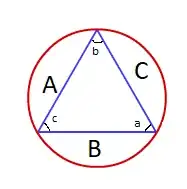A circle $O$ is circumscribed around a triangle $ABC$, and its radius is $r$. The angles of the triangle are $\angle CAB = a, \angle ABC = b$ and $\angle ACB = c$.
The area $\triangle ABC$ is expressed by $a, b, c$ and $r$ as:
$\Large r^2 \over\Large2$$\Bigg(\sin(x)+\sin(y)+\sin(z)\Bigg)$
find $x, y$ and $z$:
My approach:
Firstly, to make it clear, I set $\overline {AB} = A$, $\overline {BC} = B$ and $\overline {CA} = C$.
$\triangle ABC= \Large{Bh \over 2}$
$\triangle ABC = \Large{BA\sin(c) \over2}$
then, using the law of sine:
$r= \Large{A\over 2 \sin(a)} = \Large{B\over 2 \sin(b)}$
$A = 2r\sin(a)$
$B = 2r\sin(b)$
replacing on the formula of area:
$\triangle ABC = 2r^2\sin(a)\sin(b)\sin(c)$
But that doesn't help to answer the question. Is my approach correct, or else, what am I missing?
